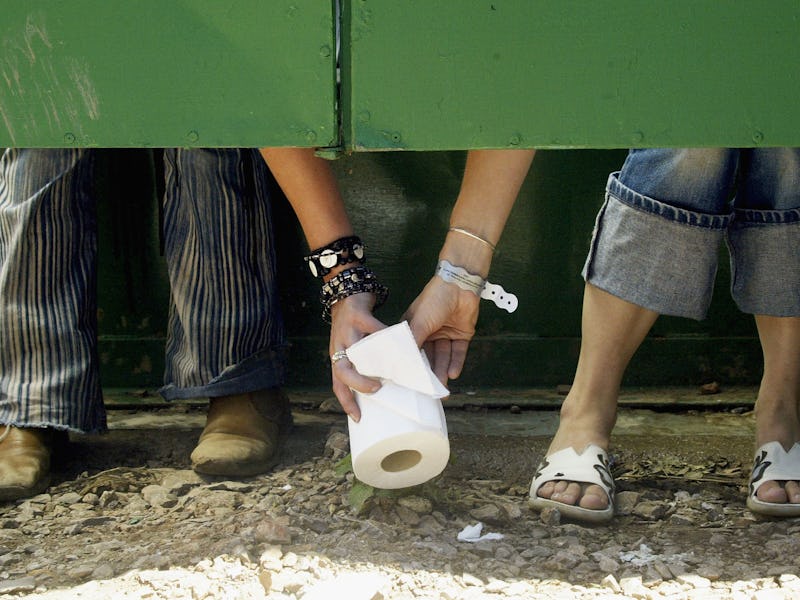Who Invented Toilet Paper?
Thank goodness somebody did.

Excerpted from New Scientist: The Origin of (almost) Everything, written by Graham Lawton and illustrated by Jennifer Daniel.
The 1850s was a golden decade for household cleanliness. It witnessed the birth of both the dishwasher and the washing machine. But neither invention was quite as revolutionary as that of Joseph C. Gayetty of New York City. In an advert in Scientific American, he declared it to be a ‘grand and unapproachable discovery’ and ‘the greatest blessing of our age’. The small print revealed what it was: Gayetty’s Medicated Paper, America’s first commercial toilet paper.
Gayetty’s announcement proved to be surprisingly provocative. Loo roll may now be considered an essential home comfort, but in the 1850s the idea of paying good money for mere ‘bum fodder’ was greeted by a chorus of mocking laughter. What was wrong with the corn husks and pages torn from newspapers, magazines and catalogues that had served so well and cost so little? Some catalogue publishers in the US had even started piercing a hole in the corner, as if tacitly accepting that their pages were destined to be hung in a latrine and used as toilet paper.
Bummed out
Gayetty’s paper hit an especially bum note among medics. According to Richard Smyth, the author of Bum Fodder: An absorbing history of toilet paper, they were particularly concerned by the assertion that the new paper could cure piles, and soon took to the pages of leading medical journals to complain.
Despite his grandiose claims, Gayetty was not the first to invent toilet paper. The Chinese had got there hundreds of years earlier. Paper had been circulating in China since the second century and it didn’t take long for people to stop reading and start wiping. Even the Emperor Hongwu, a brutal despot ruling in the fourteenth century, showed his sensitive side by ordering 15,000 sheets of extra-soft, perfumed toilet paper for his imperial household.
The Chinese also seem to have been first with another essential tool of personal hygiene, the toothbrush. Many ancient cultures used chew sticks to keep their teeth clean – in fact, all civilised people seem to have used some sort of instrument for dental hygiene – but it wasn’t until the fifteenth century, during the Ming Dynasty, that actual brushes appear. They were made from coarse pig bristles attached to a wooden or bone handle. European travellers to China brought toothbrushes home with them, and the technology spread to the west.
Toothpaste was an even earlier invention. The ancient Egyptians, Romans and Greeks used various substances to keep their teeth clean, though the ingredients were rather basic and abrasive: ashes, eggshells, pumice, powdered charcoal, tree bark, salt, crushed bones and oyster shells have all been found.
Soap – invented in Babylon around 2800 BC – was another common ingredient. The Romans added flavouring to help with bad breath. The Chinese appear to have invented the first minty toothpaste long before the toothbrush came about.
A fistful of leaves
The Chinese preference for toilet paper, however, did not travel well. The people of Britain were content with fistfuls of wool or leaves. Aristocrats would deploy scraps of linen. Or rather, they’d have someone deploy them on their behalf: a servant’s manual from the fourteenth century advises the ‘groom of the stool’ to be ready with an ‘arse-wipe’ at the critical moment.
With the advance of the printing press, people soon turned to the disused pages of pamphlets and books. As the seventeenth-century author Thomas Browne wrote: ‘He that writes abundance of books, and gets abundance of children, may in some sense be said to be a benefactor to the public, because he furnishes it with bumfodder and soldiers.’
Gayetty was not alone in his attempt to commercialise toilet paper. But it was his product that caused the biggest storm. The sheets, Gayetty declared, were ‘delicate as a bank-note and as stout as foolscap’. But what really riled the medical establishment was his claim that printer’s ink was poisonous and caused haemorrhoids, and that his paper could ‘cure and prevent piles’. There’s no truth in the claim, but that did not stop many companies from pushing loo roll as a remedy until the 1930s.
Medical journals soon went on the attack. The New Orleans Medical News and Hospital Gazette declared: ‘Mr Gayetty of New York City has found that the public mind is prepared for anything whatever in the shape of humbuggery.’ The Medical and Surgical Reporter also accused Gayetty of taking advantage of the public, drolly saying that he was attempting to ‘catch them with their breeches down’. The Lancet was less worried about the general public than the fate of the surgeons who made a good living curing piles. ‘Their occupation is now gone to the wall. All that is required is a simple piece of paper with the name “Gayetty” stamped on it.’
Where there’s muck there’s brass
But even if it didn’t cure piles, the public appreciated the comfort of toilet tissue, and it soon spawned a host of me-too products. However, consumer expectation does not seem to have been high. In the 1930s Northern Tissue was able to make a selling point of the fact that its paper was ‘splinter free!’
Today, the toilet paper industry is worth $3.5 billion annually in the US alone, with the average individual working their way through more than 20,000 sheets a year. Add that to the $3 billion spent on toothpaste and mouthwash, and it is clear that personal hygiene is big business at both ends of the alimentary canal.